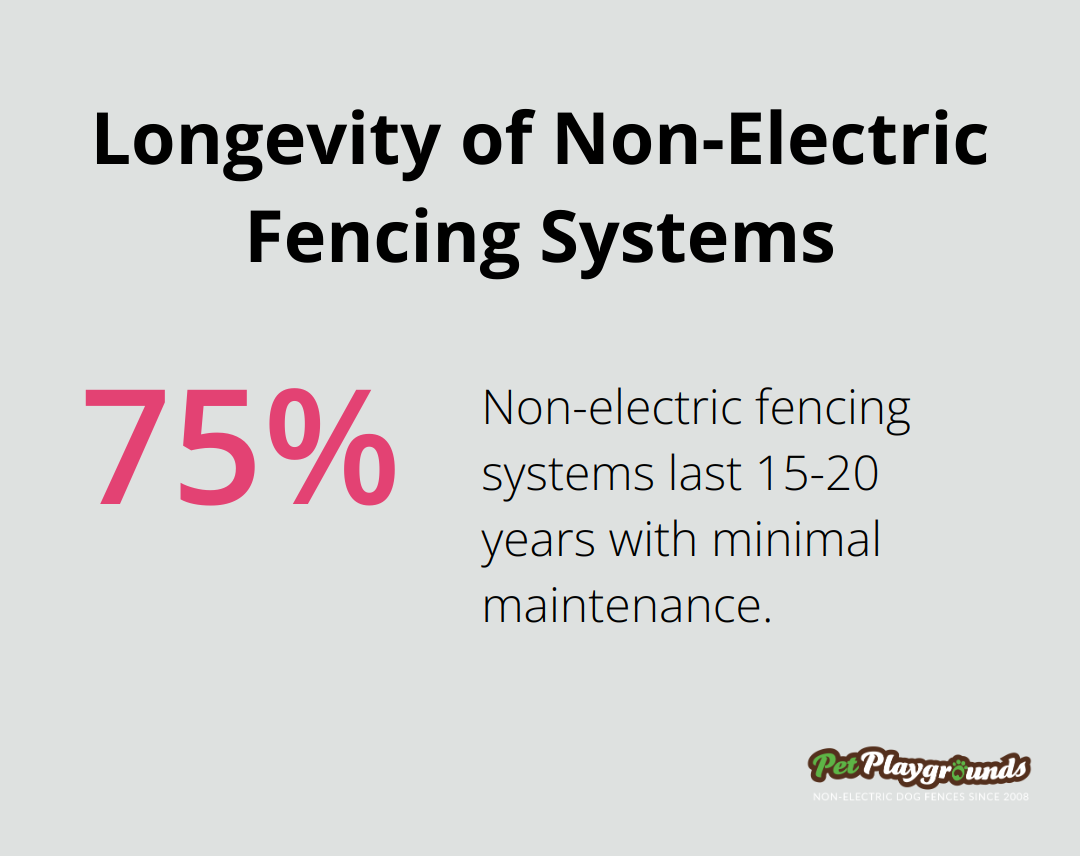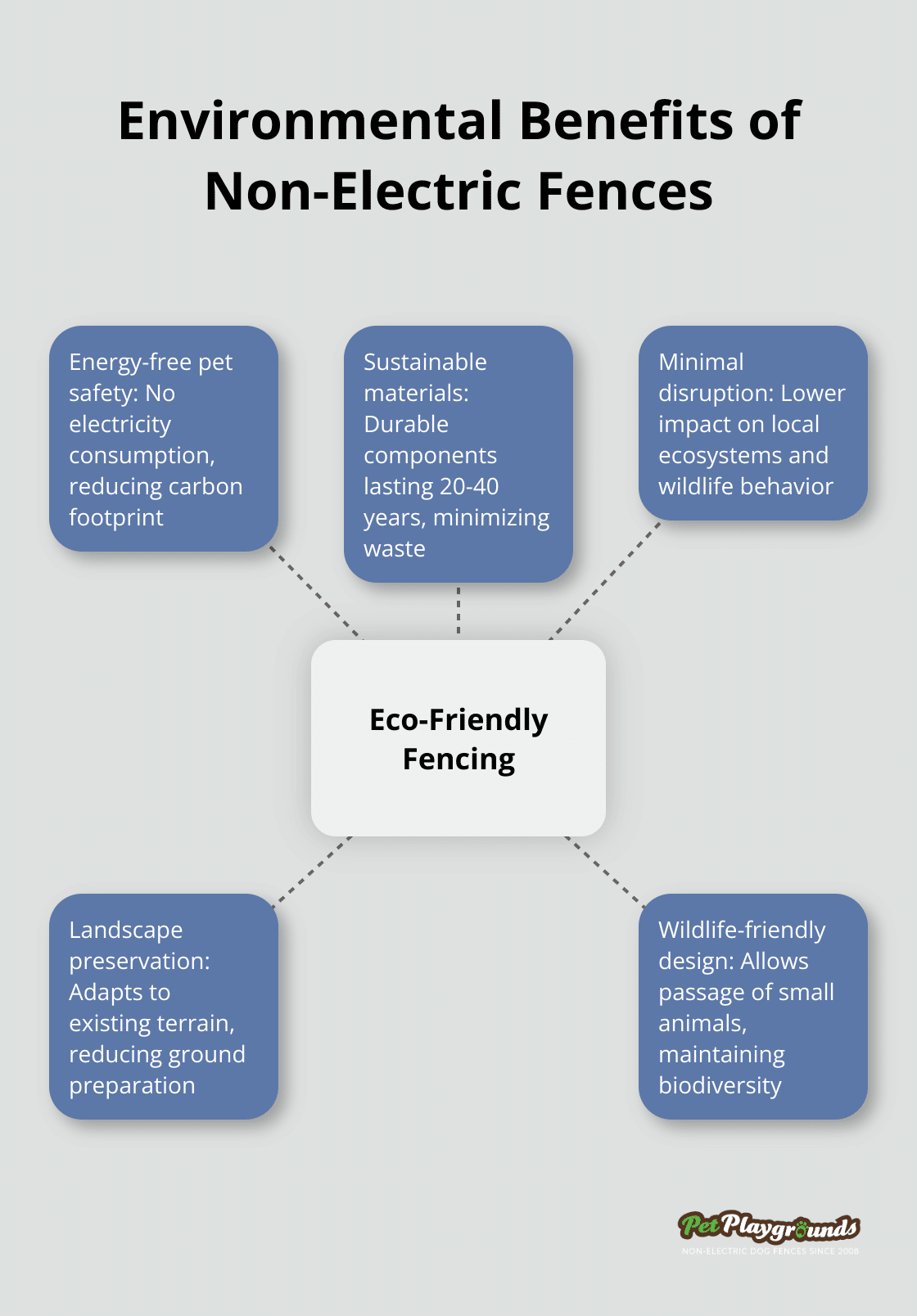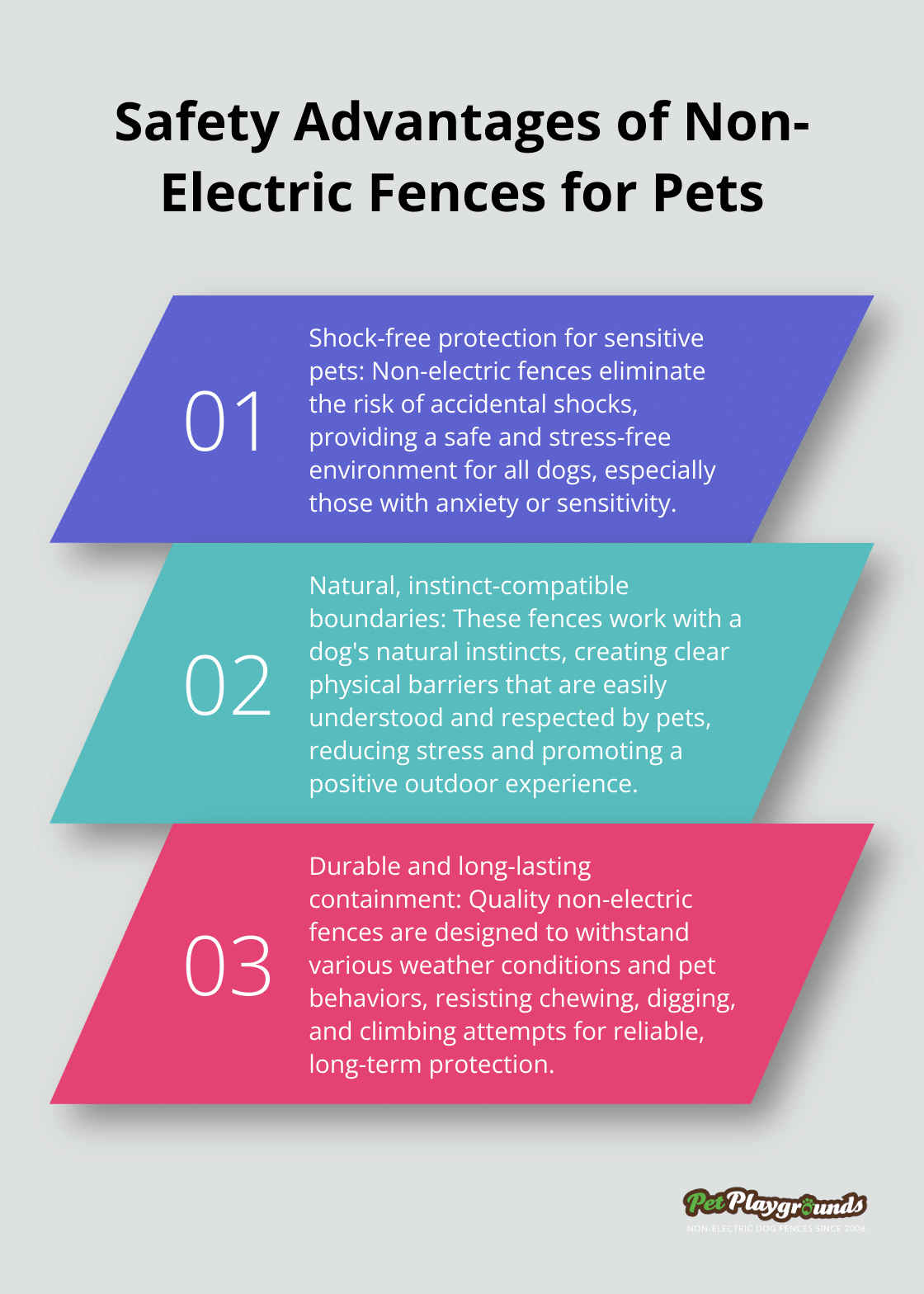At Petplaygrounds Non electric dog fence, we understand the importance of balancing pet safety with environmental responsibility. Traditional electric fences come with significant drawbacks, including high energy consumption and potential harm to wildlife.
Non-electric fences offer a compelling alternative, combining energy efficiency with eco-friendly materials. This blog post explores why these fences are the smart choice for environmentally conscious pet owners who want to keep their furry friends safe without compromising on sustainability.
The Hidden Environmental Costs of Electric Fences
Energy Consumption and Carbon Footprint
Electric fences consume energy continuously, which leads to higher electricity bills and increased carbon emissions. A 1.5-cent-per-kilowatt-hour tax credit is provided for electricity produced from wind and “closed-loop” biomass. Electric fences also come with hidden costs like electricity expenses, replacement collars, batteries, and potential veterinary bills.
Wildlife Disruption
Electric fences pose significant risks to local wildlife. From disrupting natural migration patterns to potentially harming non-target species, the relationship between electric fencing and ecosystem health is complex. This disruption to local ecosystems can have far-reaching consequences, affecting biodiversity and natural pest control.
Electronic Waste Concerns
The disposal of electric fence components presents another environmental challenge. These systems contain electronic parts, batteries, and wiring that require special handling when discarded. Improper disposal of these materials can lead to toxic substances leaching into soil and water sources, which poses long-term environmental and health risks.
Maintenance and Replacement Issues
Electric fences require regular maintenance and occasional part replacements, which further contribute to resource consumption and waste generation.
In contrast, non-electric fencing systems (such as those offered by Pet Playgrounds) are designed for longevity, with materials lasting 15-20 years and minimal maintenance requirements. These eco-friendly alternatives eliminate energy consumption, minimize wildlife disruption, and drastically reduce electronic waste.

The environmental impact of electric fences extends beyond their immediate use. The next section will explore the benefits of non-electric fences and how they address these environmental concerns while ensuring pet safety.
How Non-Electric Fences Benefit the Environment
Energy-Free Pet Safety
Electric fencing has a significantly lower carbon footprint, requiring about 75% less raw material than traditional options. Solar-powered electric fences can further reduce energy consumption, making them an environmentally friendly choice.
Sustainable Materials for Long-Term Use
Ornamental steel fencing is the most durable option for security fences, lasting 20 to 40 years and offering great strength. This extended lifespan significantly reduces the need for frequent replacements, cutting down on material waste and resource consumption.
Minimal Environmental Disruption
Non-electric fences have a lower impact on local ecosystems. They don’t emit electromagnetic fields that can affect wildlife behavior or disrupt natural habitats. Some fences (like those offered by Pet Playgrounds) use Spicy Pro-infused mesh to deter chewing without harmful chemicals, ensuring safety for both pets and the environment.
Landscape Preservation
These fences adapt to existing landscapes, which minimizes the need for extensive ground preparation or concrete use. This approach preserves natural soil structures and reduces the carbon footprint associated with fence installation. Pet owners can maintain the beauty of their yards while providing a secure area for their dogs.
Wildlife-Friendly Design
Non-electric fences can incorporate wildlife-friendly features. Adjustable heights and strategically placed openings allow for the passage of small animals, maintaining local biodiversity. This design philosophy supports the coexistence of domestic pets and wildlife, creating a more harmonious outdoor environment.

The environmental benefits of non-electric fences extend beyond their eco-friendly construction. These systems also prioritize the safety and comfort of pets, which we will explore in the next section.
How Non-Electric Fences Ensure Pet Safety
Non-electric fences provide superior safety for pets compared to electric alternatives. These fences offer peace of mind without compromising effectiveness.
Shock-Free Protection for Pets
Non-electric options eliminate the risk of accidental shocks. This feature proves particularly important for sensitive or anxious pets. The American Veterinary Medical Association notes that shock-based systems can induce fear and aggression in some animals. Non-electric fences create a physical barrier that keeps pets safe without relying on aversive stimuli.
Instinct-Compatible Boundaries
Dogs understand physical barriers naturally. Non-electric fences work with a pet’s instincts rather than against them. This approach reduces stress and promotes a more positive outdoor experience for furry companions. The American Society for the Prevention of Cruelty to Animals (ASPCA) reports that physical barriers often prove more effective for long-term pet containment.
Terrain-Adaptive Design
Non-electric fences boast versatility as a key advantage. These fences adapt to sloped yards, rocky terrain, or dense vegetation. Customization ensures no weak points exist in the pet’s containment system. Installation on various terrains occurs without extensive ground preparation (preserving the natural beauty of yards while providing a secure environment).
Wildlife Protection
Non-electric fences offer a dual benefit: they keep pets in and wildlife out. This feature proves especially valuable in areas with predators like coyotes. The physical barrier deters wild animals without causing harm, creating a safe space for pets to roam freely.
Durability and Longevity
Quality non-electric fences (such as those offered by Pet Playgrounds) use materials designed to withstand various weather conditions and pet behaviors. These fences resist chewing, digging, and climbing attempts, providing long-lasting protection. The durability of these systems translates to fewer replacements and repairs, enhancing overall safety and reliability.

Final Thoughts
Non-electric fences provide an ideal solution for pet owners who value environmental responsibility and pet safety. These fences address concerns associated with electric options, including energy consumption, wildlife disruption, and electronic waste. Pet owners can reduce their carbon footprint while creating a secure environment for their pets.
The environmental advantages of non-electric fences are significant. They operate without energy, use eco-friendly materials, and last longer, which minimizes waste generation. This energy efficiency results in lower costs for pet owners and a smaller environmental impact (while allowing wildlife to coexist more harmoniously with pets).
Pet Playgrounds Non-Electric Dog Fence offers an innovative option for eco-conscious pet owners seeking a reliable and sustainable fencing solution. Our system combines durability, adaptability, and environmental responsibility. It creates a secure environment for pets while preserving the natural beauty of your landscape.
























